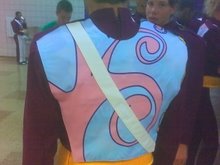Breathing Exercises for Marching Band and Drum Corps
Welcome to the wonderful world of breathing exercises! Popularized by the great tuba player Arnold Jacobs, proper breathing is now approached as a fundamental of musicianship. While many of his methods required one-on-one coaching and a variety of breathing "toys" - methods that are impractical for large group settings - in recent years they have been adapted to the world of the marching arts by teachers such as Patrick Sheridan and Sam Pilafian. The duo's "Breathing Gym" has become standard pedagogical fare throughout both the Drum Corps and Marching Band world. Many of the exercises below are based upon ones you can find in their breathing method. Since these are only verbal descriptions, I highly recommend you purchase their DVD "The Breathing Gym" for a complete visual representation of the method.
The exercises I describe below are a compilation of exercises I have been taught and teach. I in no way claim to represent the above mentioned DVD and am posting this simply for pedagogical purposes.
Free Breathing
Free breathing refers to exercises that focus solely on inhaling and exhaling full breaths of air. There are literally thousands of different permutations on this exercise and everyone seems to have an opinion on how to do it best. The most common is the metered breath, where performers inhale and exhale based upon certain timings that gauge the rate of breathing. This is usually done without instruments in hand and a raising arm motion used to visually indicate the breath. The arms move from the relaxed position at the side of the to touching over ones head on the inhale, then they are lowered back down to the resting position on the exhale. The arm motion also serves to stretch and open the chest cavity allowing a fuller breath.
Typically, the exercise will start with performers inhaling for four counts and exhaling for four counts. The focus is to move the air freely with no restriction or tension. The breath should occur evenly throughout every count of the exercise. Inhalation through the nose is sometimes implemented as it forces air to fill the lungs from bottom to top. When the mouth is opened for breathing, inhalation should be silent and also create a "cold spot" on the back of the throat. Exhaling should also be silent, however performers should feel like they are blowing out hot air. A good visual is to imagine fogging up a mirror that is placed in front of the performers' mouth.
After the "in four, out four" has been established, the inhale and exhale counts should be moved around. Shorter inhales with shorter exhales will work the lungs hard, but will teach them to move lots of air quickly, while longer inhales with longer exhales will teach how to budget the air to make it through long phrases. Some instructors dislike meters and just breath without a tempo by using a visual indicator. Some instructors will also do this exercise with instruments in hand, exhaling through the instruments. This provides a more realistic situation and also gives a little external resistance to the airflow.
Visual Breathing
This I believe comes straight from the "Breathing Gym" exercises and focuses on air at different volume levels. There are three different parts to the exercise;air at a piano dynamic, air at a mezzo-forte dynamic, and air at a fortissimo dynamic.
1. air at a piano dynamic - have the performers visualize making a paper air plane and throwing it. The goal is to link the idea of the smooth gentle toss of the the paper airplane to the gentle slow air that they use to play at a piano dynamic. As they toss their imaginary air planes, have them exhale and visualize their air gliding along the flight path of the plane.
2. air at a mezzo-forte dynamic - have the performers visualize throwing a dart while exhaling with their air. The air is faster and a little more directional. The gentle air that pushes the paper air plane will not work for a dart.
3. air at fortissimo - this is the fun one. Visualize using your air to shoot a bow and arrow. Have the performers pantomime pulling back the bow in the inhale then shooting the arrow forward with a very fast and directional stream of air.
During every step a "hiss" may be added to the end of the exhale when the performers feel they have expelled 90% of their air. The hiss is used not only to aurally indicate when the performer runs out of air, but also to engage the abdomen in expelling the last bit of air out of the lungs. Personally I do not find this helpful to do as it introduces unneeded tension into the exercise.
Fight for air
The purpose of this exercise twofold - 1. to get as much air into the lungs as fast a possible without tension; and 2. to stretch and strengthen the muscles of the chest and diaphragm.
The exercise begins by performers exhaling all of the air in their lungs (this means pushing out the air that naturally fills the lung cavity for equalizing pressure). Immediately the students are to cover their mouth with the back of their hand to create an airtight seal. Students then "suck" on the back of the hand as if they are fighting to pull air through the hand. After a few seconds (5-10) of fighting for air, performers are to pull their hand away from their mouth and allow their lungs to naturally fill with air. The inhale should be free from tension and obstruction and should happen immediately upon removal of the hand. Students should then exhale naturally. If this exercise is done correctly, the ensemble should be coughing their brains out afterwards. This is not necessarily a bad thing. Coughing can be good if it occurs as a result of air rushing into new areas in the lungs that are not used to being filled so quickly. Coughing is bad if it is the result of some obstruction in the throat cavity on the inhale.
The sip
The goal of this exercise is to increase the lung capacity of the performers. Performers take in a full breath and hold it in. After a moment or so, they sip in more air into their lungs. This is repeated a few times before finally exhaling. The performer is encouraged to try and fill up completely on the first inhale so it is impossible to sip any air. The body heating the inhaled air, coupled with the forcing of more air into the lungs on the sips leads the lungs to expand and stretch. Over time, lung capacity is increased.
The Blade
This exercise is more about perception and psychology than actual breathing technique. The performer holds his hand in front of his opened mouth longways so that his index finger is touching both the upper and lower lips and the point is touching his nose. The hand should have fingers closed and be oriented so the pinky finger is furthest from the face.
The performer inhales and exhales in one count pushing his hand away from the face with his airstream. The goal is to completely fill the lungs in a single count by inhaling with your hand obstructing the air stream. The only way to be successful at the inhale is to stay relaxed and open the airway to allow more air in. The only sound heard should be that of air rushing around the front and back of the hand to get into the lungs.
The next part of the exercise is to move the hand so it is about an inch away from your face. When you inhale this time, you mind still perceives you hand as an obstruction to the airstream and the inhale should be just as relaxed and open. This is good for replicating the obstruction of the mouthpiece when playing an instrument.
Conclusion
All of these exercises are only effective if done consistently and if the performers have a full understanding of the goals and reasoning behind each one. The goal of all of these exercises is to create, as habit, taking in full relaxed breaths when playing an instrument.drum corps ;
DCI ;
marching band
Continue reading...

